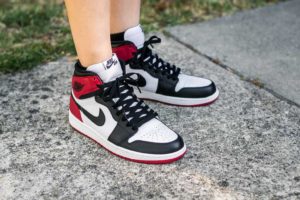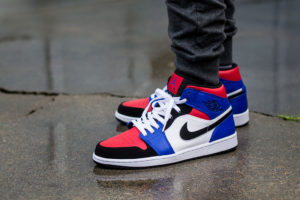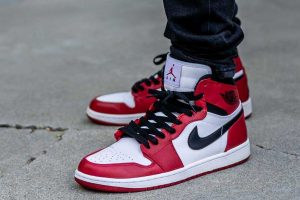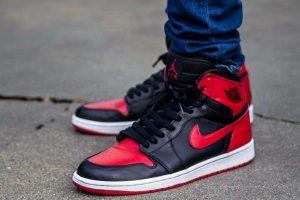Generally, the Jordan 1 High is seen as the “cool” J1. The other cuts, not so much. Sneaker collectors claim a number of reasons as to why this may be. Here we examine why people seem to dislike Air Jordan 1 Mids.
What People Have Against Air Jordan 1 Mids
Reasons for the attitude towards Jordan 1 mids include a less “OG” cut, lack of Nike Air branding, perceived lack of quality materials and colorways and high availability/lack of exclusivity.

A pair of AJ1 Highs with Nike Air
branding on the tongue seems to
be the pinnacle of what sneaker
collectors want in their Jordan 1s.
Shop Air Jordan 1s: eBay
For anyone with experience collecting kicks, Air Jordan 1 highs are definitely the go-to as far as J1s go. It is now to the point where many can’t even express why the higher cut is more coveted. While some reasons for this are understandable, there is also a bandwagon effect when it comes to the hightop version of the sneaker.
The mid is generally seen as inferior when compared to the highs or even the lows. In my opinion, the importance of the cut of the J1 is a bit overstressed by collectors; it’s really not that important which cut of Jordan 1 you choose to get, as long as you like what you are buying. This is especially true from a fashion standpoint. However, from a collecting standpoint, the mid tends to take a backseat to the high.
The reasons generally cited for the mid hate are the lack of staying true to the “OG” cut, lack of Nike Air branding, poor quality materials, poor colorways and wider availability.
How Air Jordan 1 Mids Are Cut Differently From Highs
Besides the lower height, Air Jordan 1 mids have 8 lace holes instead of the 9 found on the highs. Mids tend to have a more “squat” appearance and cover less of the ankle.

This was the last pair of mids I bought.
Note the lower cut by the ankle and
8 lace holes instead of 9
The Jordan 1 mid definitely has a different appearance to the highs, although they may look similar to the untrained eye. For non-collectors, they both seem like hightop sneakers in the Jordan 1 silhouette. For sneaker enthusiasts, there are more subtle differences in appearance.
Putting a pair of mids and highs side by side, the differences become more apparent. The shorter height on the Jordan 1 mid equates to less lace holes. The typical AJ1 mid has 8 lace holes, vs the 9 found on most high versions of the sneaker.

This version is from 2013. It was sold as an
Air Jordan 1 high, yet note the 8 lace holes and
lower cut.
This changes the proportions of the mid in a way that is pretty significant. The lower height on the ankle gives the mid a more chunky appearance. The J1 high tends to have this slender, fitted look to it, while the mids appear more bulky and wide. This is not only in appearance; in my experience the mid tends to have a slightly more accommodating fit, especially around the toebox.
Interestingly enough, many claim that Michael Jordan himself wore mids on court. Additionally, until around 2013-2015, what was considered a “high” is actually what is now considered a “mid”. Meaning Air Jordan 1 highs were actually released in more of a mid cut until Nike decided to “bring back the OG shape”.
Air Jordan 1 Mids Lack Nike Air Branding
One reason for Jordan 1 mid hate is the lack of Nike Air branding on the tongue. This branding is seen as truer to the original releases of the Air Jordan 1.

This model was the first to feature the Jumpman
logo, which would later symbolize Jordan Brand
Shop Air Jordan 3s: eBay
The Jumpman has existed since before Tinker Hatfield put it on the Air Jordan 3. However, it wouldn’t be put on a Jordan 1 until after Jordan Brand became it’s own entity in the 90s.
As mentioned above, for a while, this was the only type of AJ1 we could buy; mid cut with a Jumpman logo on the tongue. For sneaker collectors of the time, this was the Air Jordan 1 High. It wouldn’t be until the early-mid 2010s that a distinct “OG” high cut would be developed.
Once Nike figured out that the higher cut and Nike Air branding on the tongue spoke more to collectors (and hypebeasts), they began capitalizing on this. More and more “OG High” colorways began to release. As new collectors entered the arena, it began to be taken for granted that highs were more “OG” than mids and were therefore more desirable. And the lack of Nike Air on the mids’ tongue was an easy identifier symbolizing the “uncool” cut of J1.
Note that both the mid and high cut Air Jordan 1 have Nike Air in the midsole. While this doesn’t affect the comfort as much as one would think, this point should be clarified, since some believe the lack of Nike Air on the tongue means no tech in the shoe.
Air Jordan 1 Mid vs High Quality
Generally speaking, the Air Jordan 1 is an average quality sneaker. Hype over the high cut of the model has helped spread the perception that the highs contain better materials than the mids. This is not always the case.

Although this pair has the high cut, the quality
is notoriously bad as far as the plasticky leather
used on this release.
Jordan 1 mids do tend to use a lower quality material due to high production numbers on many colorways. Generally speaking, mids are a bit more mass produced, which leads to lower quality QC and materials overall. This does not mean that the highs are so much more superior or consistent in this regard though.
In fact, a number of Air Jordan 1 highs have at best, average materials. There have been some pairs of J1s that are infamous for having questionable quality as far as construction. Regardless, I understand how one might think how the highs are better overall, if for no other reason than that there aren’t many stand-out pairs of mids as far as quality is concerned. That said, a number of premium pairs of mids have released, particularly within the last few years, that have focused on increased quality and exclusivity, making them almost as coveted as some hyped-up pairs of highs.
One thing I have noticed as far as general release pairs is that the tongue material on the mids is usually different than that of the highs. J1 highs tend to have a thin nylon tongue, while the mids are often more padded.
Air Jordan 1 Highs Are Typically More Exclusive Than Mids
The perceived high availability of Jordan 1 mids as compared to highs results in more hype for the highs. This leads to AJ1 highs generally selling out faster than mids, which feeds into the perception of exclusivity.
This seems to be a cycle where the general belief that the highs are more exclusive becomes a self-fulfilling prophecy. Collectors tend to ignore the mids and go for the highs.
We also see mids around a lot on the average non-sneakerhead. It may be hard to believe for collectors, but the average non-collector that wants a pair of Jordans might just go into a store and grab one that they like, without worrying about how limited or coveted the sneaker is. Nikes awareness of this leads to a lot of mids being produced.
It appears as though Jordan 1 mid colorways release in high volumes. The reality is that both cuts are produced in high numbers, although the mids might take the edge here. Still, many colorways of Air Jordan 1 high are far from “exclusive” or “limited”. The hype is there for the highs though, which generally causes them to sell out faster than their mid-top brethren. The perception that the highs are less available is continued with each sold-out release.
While the high cut AJ1 may in fact be more limited on a per-release basis, that doesn’t mean that some pairs of mids aren’t also limited. Some collabs and premium pairs of Jordan 1 mids are actually more limited than highs that released around the same time.
Conclusion
If your collector instincts tell you to go for a pair of highs over a pair of mids, I do not blame you. After all, the Air Jordan 1 high is one of the most desired silhouettes among collectors. That said, I wouldn’t turn my nose up at a pair of mids if I liked how the shoe looked. Plenty of people rock mids and they can look great on feet. The sneakers may also be more comfortable depending on personal preference, desired level of ankle support and individual foot shape.
At the end of the day, preferring the high-top J1 is a personal thing. There’s no problem with this, however, looking down on those that wear Jordan 1 mids is unnecessary and illogical. Both are part of a lineage of one of the most successful sneaker models of all time, and it ultimately comes down to personal preference as to what cuts and colorways we each want to rock.
